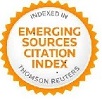Retórica en la Estoria de Espanna de Alfonso el Sabio
Abstract
The redactors of the two Alfonsine histories are perhaps more grammatical than rhetorical; the free Castilian versions of their Latin originals are more notable for their clarity than for their eloquence. The editors do, however, apply two figures of rhetoric routinely throughout their text, transitio and aetiologia. A few passages on the Estoria de Espanna go much further. Two narratives there feature dramatic application of two Quintilianesque figures of amplification, comparatio and ratiocinatio. Other sections display a sort of quasi-classical prose, notable for its artful isocola and antitheses, and marked by a fine concern for prose rhythm. This last feature might suggest that the compilers had some knowledge of the ars dictaminis.
Downloads
References
ALFONSO EL SABIO (1955), Primera crónica general de España. Ed. Ramón Menéndez Pidal. Madrid: Gredos.
BERTOLUCCI PIZZORUSSO, VALERIA (1967), “Un trattato di ars dictandi dedicato ad Alfonso X”. In Studi mediolatini e volgari, XV, pp. 9-88.
CATALÁN, DIEGO (1962) De Alfonso X al Conde de Barcelos. Madrid: Gredos.
EUTROPIUS (2002), (Eutrope), Abrégé d’histoire romaine. Texte établi et traduit par Joseph Hellegouarc’h. Paris:Les Belles Lettres. References are by book and chapter.
FARAL,EDMOND (1962), Les arts poétiques du XIIe et du XIIIe siècle. Paris: Honoré Champion.
FAULHABER, CHARLES (1973), “Retóricas clásicas y medievales en bibliotecas castellanas”. In Ábaco, IV, pp.151-300.
____ (1978), “The Summa dictaminis of Guido Faba”. In Murphy, 1978, pp. 85-111.
FRAKER, CHARLES F. (1996), The Scope of History, Studies in the Historiography of Alfonso el Sabio. Ann Arbor: University of Michigan Press.
ISIDORE, SAINT (1863), De arte rhetorica. In C. Halm. Rhetores latini minores. Leipzig: Teubner, pp. 505-522.
____ (1911), Etymologiarum siue originum libri XX. Edited by W.M. Lindsay. Oxford: Clarendon Press.
JULIUS CAESAR (1961), Bellum gallicum. Edited by Otto Seel. Leipzig: Teubner. Reference by book and chapter.
JUSTIN (1972), M. Ivniani Ivstini Epitoma historiarvm philippicarvm Pompei Trogi. Edidit Otto Seel. Stuttgart:Teubner. References are by book and chapter.
LAUSBERG, HEINRICH (1975), Manual de retórica literaria. Translated by José Pérez Riesco. Madrid: Gredos.
LUCAN (1959), The Civil War. Translated by J. D. Duff. Cambridge: Harvard University Press; London: Wm. Heinemann. References are by book and verse.
MANITIUS, MAX. (1935) [1965], Handschriften antiker Autoren in mittelalterlichen Bibliothekskatalogen. Leipzig: Harrassowitz. Reprint, New York: Octagon Books.
MURPHY, JAMES J., ed. (1978), Medieval Eloquence. Berkeley, Los Angeles, London: University of California Press.
____ (1974), Rhetoric in the Middle Ages. Berkeley, Los Angeles, London: University of California Press.
OROSIUS (2003), (Orose), Histoires (contre les païens). Texte établi et traduit par Marie-Pierre Arnaud-Lindet. Three volumes. Paris: Les Belles Lettres. References are by book, chapter and paragraph.
QUINTILIAN (1920-1922), Institutio oratoria. English translation by H.E. Butler. Four volumes. Cambridge: Harvard University Press; London: Wm. Heinemann. References are by book, chapter and paragraph.
REYNOLDS, L. D., ed. (1983), Texts and Transmission, a Survey of the Latin Classics. Oxford: Clarendon.Rhetorica ad herennium. (1954). With a translation by H. Caplan. Cambridge: Harvard University Press; London: Wm. Heinemann. References are by book and chapter.
RICO, FRANCISCO (1972), Alfonsoel Sabio y la “General estoria”: tres lecciones. Barcelona: Ediciones Ariel.
RODRIGO TOLEDANO (1793), PP. toletanorum quotquot extant opera. Tomus tertius: Roderici Ximenii de Rada, Toletanae ecclesiae praesulis, opera praecipua complectens. Madrid: apud viduam Ioachimi Ibarra. References are by chapter.
SCAGLIONE, ALDO (1978), “Dante and the Rhetorical Theory of Sentence Structure”. In Murphy 1978, pp. 252-69.
TOYNBEE, PAGET (1923), “The Bearing of the Cursus on the Text of Dante’s De vulgari eloquentia”. Proceedings of the British Academy 10, pp. 359-377.
TRANSMUNDUS (1995), Introductiones dictandi. Text edited and translated by Ann Dalzell. Toronto: Pontifical Institute of Mediaeval Studies.
VIPERANO (1569), Io. Antonii Viperani de scribenda historia liber. Antverpiae: Christophori Plantini.












